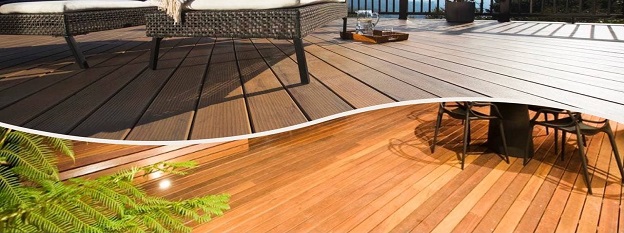- 22 Apr, 2021
Decking creates welcoming and cozy spaces where you can relax and have beautiful time with family or friends, in the sunny day or under the stars. However, these outdoor spaces haven’t always been as durable and attractive as they are nowadays.
There are two the most common options: tropical hardwood and wood-plastic composites.
Frequent question “What to choose”?
Both material have their pros and cons. Let’s take a look in details.
Tropical Hardwood Decking (IPE, Cumaru, Merbau and e.t)
Advantages:
- Natural wood timber comes in varies species
- Wide range of colours naturally occurred
- Durable, insect rotting resistant
- Lower initial spend
- Can sand away scratches, dents, or worn areas
- Re-stain so that they look as good as new
- Life 40+ years with the proper maintenance
- 100% recycled
- Better load bearing
Disadvantage:
- Irregularity of production. Not always guaranteed to get the same quality if you buy in different patches
- Requires regular maintenance:
- Yearly cleaning & resealing yearly
- Annual oiling and staining
- Maintenance cost.
- Limited warranty.
Wood-Plastic Composite or WPC (we are only using TimberTech/AZEK American product which has highest quality)
WPC invented in the late 1991s. This material is made from combined reclaimed plastic and wood fiber.
Advantages:
- An inner core made of recycled wood & plastics
- Up to 80% recycled material
- Easy cleaning and no maintenance
- Non prone to damage from termites & insects
- Resistant to mold and moisture
- Splinter free
- High durable (fade & stain resistant)
- Easy to work (can be bend)
- Wide range of colours
- 30 & 25 years warranty Fade & Stain
- UV & weather protective
Disadvantage
- Higher initial cost
- less load bearing.
- Higher heat buildup.
Installation Cost
Tropical hardwoods have a much wider range of both width and thickness than composite boards, giving them an advantage in strength and durability. Wood is generally quicker and less expensive to install than composite. Composite decking requires more support than wood decking. This issue can be easily overcome by placing the joists closer together to support the deck and prevent sagging or breakage, but the additional substructure material can increase the cost of the deck structure.
Look and Feel
Both materials have many variations and have their own advantages and disadvantages, depending on the preferences. Composite decking is less slippery than hardwood decking. Even though, manufacturers can make composite decking look like real wood, it is not possible to truly imitate the natural texture, shade variation and authentic appearance of real wood. Also, composite decking can never feel like natural wood.
Nevertheless, all come to individual choice, preference, interest.
If you want a deck look natural as the outdoors and ready for frequent maintenance, then wooden deck boards would be the best option. Whereas, composite decking is the hassle-free material and would be convenient for the homeowners who has no time for maintaining.

